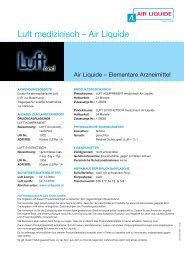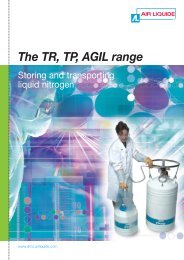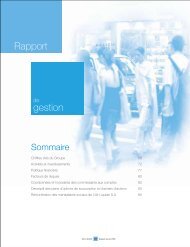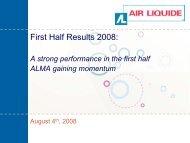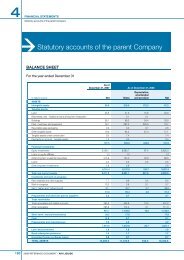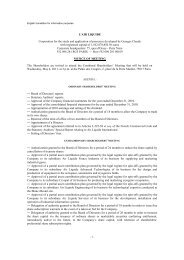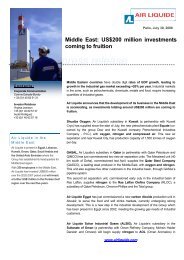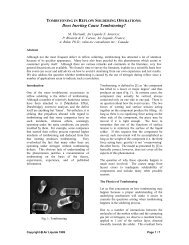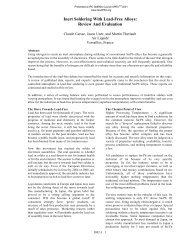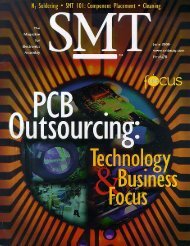EVALUATING NITROGEN STORAGE AS AN ALTERNATIVE
EVALUATING NITROGEN STORAGE AS AN ALTERNATIVE
EVALUATING NITROGEN STORAGE AS AN ALTERNATIVE
You also want an ePaper? Increase the reach of your titles
YUMPU automatically turns print PDFs into web optimized ePapers that Google loves.
<strong>EVALUATING</strong> <strong>NITROGEN</strong> <strong>STORAGE</strong> <strong>AS</strong> <strong>AN</strong> <strong>ALTERNATIVE</strong><br />
TO BAKING MOISTURE/REFLOW SENSITIVE COMPONENTS<br />
Martin Theriault<br />
Air Liquide America, Countryside, IL USA<br />
C. Carsac, P. Blostein<br />
Air Liquide, Versailles, France<br />
Abstract<br />
The introduction of surface mount devices (SMDs) has significantly contributed to the<br />
advancement of electronic assembly. SMDs, however, especially plastic ones have the<br />
disadvantage of being sensitive to moisture. Moisture from atmospheric humidity diffuses<br />
through the permeable SMD package and if the moisture level inside the package reaches a<br />
critical point, the device may be damaged when brought up in temperature during the reflow<br />
process. These types of moisture-induced failures, also called ‘popcorning’, are of particular<br />
concern as they are often undetectable and they greatly impact on product reliability.<br />
To prevent this from happening, PCB assemblers traditionally ‘bake’, at elevated<br />
temperature, components that have exceeded their floor life (as dictated by their IPC / JEDEC<br />
level). While baking prevents moisture-induced failures and popcorning, it also adds timely and<br />
expensive steps to the assembly process. Additionally, baking alters the component<br />
solderability, grows the intermetallic compounds layer, poses carrier compatibility problems,<br />
and may create bottlenecks and logistic issues. Baking, like rework, is a reactive process to<br />
correct a problem and should not be considered as a normal part of the assembly process. It<br />
may be necessary but efforts should be made to limit or eliminate it.<br />
Another option as an alternative to baking is to adopt a pro-active measure by limiting<br />
the component exposure to ambient air humidity. The present study investigates the power of<br />
ambient or near-ambient temperature dry gas to eliminate moisture-induced failures and avoid<br />
baking. Experiments on the effectiveness of a dry gas (nitrogen) environment to prevent<br />
moisture absorption are detailed. And when components still have to be dried or baked, the<br />
ability for the same dry gas environment to remove moisture is researched. For the practical<br />
application, the same storage atmosphere at ambient or near-ambient temperature is<br />
evaluated to determine if this environment can achieve both moisture prevention and drying.<br />
The results demonstrate that the storage of moisture-sensitive components in a dry<br />
(nitrogen) environment is an attractive solution for PCB assembly facilities. Overall, a<br />
preventive dry storage solution, combined with a tight moisture-sensitive devices management<br />
system, may represent the best solution to avoid and ensure moisture-free defects in reflow<br />
soldering. Dry storage could help assemblers control the problems created by the continuous<br />
integration of components and the emergence of lead-free soldering which increase the<br />
moisture-sensitivity of SMDs.<br />
Proceedings of NEPCON WEST 2000; Anaheim, CA, USA; copyright © AL 2000 Page 1
Introduction:<br />
Moisture the Enemy of Surface Mount Devices<br />
The introduction of surface mount devices (SMDs) has significantly contributed to the<br />
advancement of electronic assembly. Plastic SMDs, especially, have gained extreme<br />
popularity as they offer versatility and the inherent low cost of plastic packages. These<br />
devices, however, have the disadvantage of being sensitive to moisture. Moisture from<br />
atmospheric humidity diffuses through the permeable SMD package and if the moisture level<br />
inside the package reaches a critical point, the device may be damaged when brought up in<br />
temperature during the reflow process. The rapid increase and high vapor pressure in the<br />
package, combined with the thermal mismatch stress the component. Typical component<br />
failures include die cracking, internal corrosion, bond wire damage, and, in the worst case,<br />
external cracking. This is also referred to as the popcorn effect due to the audible popping at<br />
failure.<br />
Numerous papers [1] [2] describing and analysing the diffusion of moisture in plastic<br />
surface mount devices have concluded generally that 1) the ambient temperature affects the<br />
rate of absorption, and 2) the relative humidity affects the saturation level. Other studies [3]<br />
have also found that the rate of diffusion of moisture through the package of a component<br />
depends also on the polymer forming the package, its thickness and the time of exposure to<br />
moisture. For a given encapsulation material and for components removed from their “dry<br />
pack”, the rate of penetration of moisture is generally inversely proportional to the square of<br />
the thickness of the material. That is, the thinner the package, the faster the moisture<br />
absorption will be. Compared with DIP, QFP or PLCC with a comfortable thickness, new and<br />
exotic packages such as TSOP, PBGA, PQFP and UTQFP can be, according, to this estimate,<br />
15 to 20 times more sensitive to moisture. These findings explain why thinner package obtains<br />
a higher moisture-sensitivity level when tested for moisture absorption.<br />
IC manufacturers have worked hard and succeeded partially at diminishing this<br />
problem. Mould compounds, mould process, and window pad leadframe have all been<br />
improved and lessen the problem associated with moisture absorption. Additionally,<br />
assemblers have learned to take the necessary precautions to avoid, or at least greatly<br />
reduce, the harmful effects of moisture and popcorning. However, the continuous reduction in<br />
packages and higher density interconnects necessary to make devices better, faster, and<br />
cheaper are putting the problem back on the agenda. And with lead-free on the horizon and<br />
the higher reflow temperature it will command, moisture sensitivity issues will become more<br />
predominant.<br />
All in all, the problems related to moisture nevertheless persist. SMDs are not truly<br />
hermetic and they are exposed to humidity in a factory production environment. We found it<br />
therefore opportune to examine here the current and potential solutions.<br />
Current Solution: Floor Life Compliance and Moisture Removal<br />
Moisture-induced failure, including popcorning, are of particular concern as they are<br />
often undetectable and they greatly impact product reliability. These types of failures may lead<br />
to latent defects or field failure. The final product may fail in the field when aggressive gases<br />
Proceedings of NEPCON WEST 2000; Anaheim, CA, USA; copyright © AL 2000 Page 2
of the product environment attack open cracks. It is therefore critical for PCB assemblers to<br />
only reflow components that are dry or have a very low and ‘safe’ moisture content. The level<br />
of moisture measured in weight gain by % at which a component will fail depends obviously on<br />
numerous factors such as the component itself and the subjected reflow temperature.<br />
Determining the weight gain % failure level is therefore component specific and experimental.<br />
Generally, it has been found in some studies [2] [5] that moisture gains of less than 0.1% do<br />
not cause any failures while moisture gains greater than 0.1% pose a certain risk and gains<br />
beyond 0.2% create a significant risk (see figure 1). These values are not valid and should be<br />
revised if higher melting point alloys or (lead-free soldering) is performed.<br />
Figure 1:<br />
To avoid moisture-induced failures and popcorning, it is necessary to scrupulously<br />
comply with the floor life recommended by the manufacturer of the component. The moisture<br />
sensitivity (MS) level to which the product has qualified (IPC/JEDEC J-STD-020A) [4] indicates<br />
the floor life. In everyday practice, this is not always evident for practical reasons (tracking).<br />
By way of precaution, and when the floor life has expired, the J-STD-020A specifications<br />
recommends to ‘bake’ the components in order to remove the moisture they have gained from<br />
ambient humidity exposure. Baking as per the standard is normally done at an elevated<br />
temperature for a period varying from 24 hours (125°C) to 8 days (or more, 40°C). Baking<br />
normally concerns only components of level 3 to 6 due to their relatively short floor life.<br />
Baking and worries about potential failure caused by moisture generally do not apply to<br />
pin-through-hole (PTH) components [4]. Wave soldered PTH components do not reach a<br />
temperature high enough to create moisture-induced failures. They typically only reach 140°C<br />
versus 220°C for reflow components. In reflow soldering, the convective nature of the heating<br />
process makes the package reach the highest temperature of the profile. The advantage in<br />
wave soldering is that the package is on the top of the PCB does not come in contact with the<br />
higher wave. Only the leads touch the flows of the 260°C solder at the bottom of the PCB.<br />
Pin-through-hole components are therefore exempted from this defect source with the<br />
exception of PTH components that are soldered in a pin-in-paste reflow process.<br />
Figure 2 shows the images obtained by scanning acoustic microscopy examination of<br />
the interface between the lead frame and the coating material of a PLCC 68 soldered by wave<br />
and reflow respectively [6]. The effect of an increase of package temperature can be clearly<br />
Proceedings of NEPCON WEST 2000; Anaheim, CA, USA; copyright © AL 2000 Page 3
seen (the delamination zone is light in the image). The probable evolution in the near future to<br />
lead-free alloys, with their associated higher melting temperatures than traditional tin/lead<br />
alloy, will increase this effect dramatically.<br />
Wave Reflow<br />
Figure 2: SAM of Component after Wave and Reflow Soldering<br />
While baking prevents moisture-induced failures and popcorning, it is rather difficult to<br />
manage [7]. Comprehensive floor life tracking is often impractical, so assemblers take risks<br />
(reflow ‘wet’ components) or simply perform a bake-out on all high-level components⎯a timeconsuming<br />
task which brings supply and logistic issues. A high-baking temperature may be<br />
incompatible to the chip carrier and the solution is to remove the components from the carrier<br />
creating handling, ESD, and other issues or performing a long 8-day (or more) bake [4].<br />
Additionally, PCBs awaiting a 2 nd pass reflow or rework are also subject to moisture gain.<br />
Baking in these situations can sometimes be difficult and generates additional concerns.<br />
Assemblers sometimes seal their components in a dry bag after the baking process.<br />
This bake-and-bag process is also called dry packing. A dry pack consists of desiccant<br />
material and a humidity indicator card sealed with the components inside a moisture barrier<br />
bag. The bags do not provide a completely dry environment [4] but is sufficient to maintain the<br />
components below the 0.1% weight gain safe zone. Overall, the use of a vapor-proof bags<br />
and desiccant material is an effective way to maintain components dry prior to the reflow<br />
process. However, the process is timely, labor intensive, and requires floor space. The bags<br />
themselves, desiccant, and humidity indicator add to the operating costs [8].<br />
Baking also alters the solderability of components and ages them by growing the<br />
intermetallic layer of the component joint structure. Solderability is known to be reduced by i)<br />
the oxides that naturally grow over the surface coating protecting the component leads, and ii)<br />
growth in the intermetallic layer of the lead/coating interface. With a lower solderability, proper<br />
soldering becomes difficult to carry out without resorting to more aggressive fluxes as well as<br />
high-soldering temperatures.<br />
The growth of the intermetallic compounds is not interrupted during storage. For<br />
coatings with a total thickness ranging from 2 to 20 microns, the intermetallic thickness at the<br />
end of production may, for example, be 0.7 microns and a growth of about 1 micron per year<br />
has been reported [9]. When the thickness of the coating may be reduced in certain places,<br />
solderability problems may arise even after short period storage.<br />
Proceedings of NEPCON WEST 2000; Anaheim, CA, USA; copyright © AL 2000 Page 4
Obviously, baking performed at elevated temperature considerably accelerates the<br />
growth of the layer of intermetallic compounds. Using the modelling data provided by the<br />
National Physical Lab Teddington, UK [10], the growth of the intermetallic layer on copper for<br />
an electrolytic coating of 60/40 tin/lead can be calculated. We obtain a growth of the<br />
intermetallic layer of about 1 micron per 24-hour cycle of drying at 125°C. This value is<br />
considerable compared with the figures noted above, especially since the same source clearly<br />
indicates that, for certain coatings, this growth has a dendritic appearance due to the<br />
preferential paths of diffusion of the tin. In these unfavourable conditions, the growth of the<br />
intermetallic layer is much greater. Rates of growth up to four times as high have been<br />
reported. That is, each 125°C baking cycle ‘ages’ the component by 1 to 4 years.<br />
All in all, baking adds timely and expensive steps to the assembly process. Baking, like<br />
rework, is a reactive process to correct a problem and should not be considered as a normal<br />
part of the assembly process. It may be sometimes necessary but efforts should be made to<br />
limit or eliminate it.<br />
Alternative Solution: Moisture Prevention<br />
Until IC manufacturers fabricate truly hermetic packages, the best and simplest way to<br />
eliminate moisture-induced failure and popcorning may reside in preventing moisture from<br />
being absorbed by the components. It is basic, if SMDs do not absorb moisture then they can’t<br />
fail due to moisture and baking/dry packing and their associated issues becomes unnecessary.<br />
The first approach to prevent H2O related failures and baking is to scrupulously comply with<br />
the floor life of the component as classified by the IPC/JEDEC standard. As discussed<br />
previously, this is sometimes difficult because of floor tracking and because new and exotic<br />
packages have a floor life that is shorter. Another approach is to use dry cabinets but there<br />
are still times when the components can absorb moisture and raise the risk of moistureinduced<br />
failures. However, recent developments and a better understanding of the problem<br />
may now allow the complete elimination of baking.<br />
N2 is now a common gas in electronic assembly so that adopting a N2-based and<br />
preventive solution might be simple for manufacturing locations to incorporate in their facilities.<br />
Additionally, when nitrogen, a clean, reliable and dry gas source, is used, the solderability of<br />
the components is preserved over time. In the assembly industry, and more specifically in<br />
microelectronics, storage in nitrogen is a solution that has already been acknowledged and<br />
used industry-wide for years during production. Nitrogen to preserve solderability and the<br />
integrity of the component is used more and more often for the long-term storage of obsolete<br />
or strategic electronic components in military and aerospace industries. The same trend can<br />
be seen in the automotive industry where reserves of ICs must be made to support<br />
replacement electronic parts for the future.<br />
In this study, we decided to investigate the use of a dry gas (nitrogen) environment to<br />
prevent moisture absorption. First, how effective is a dry environment to prevent moisture<br />
absorption? What is the correlation between the humidity of the controlled atmosphere and<br />
weight gain? Second, when components have absorbed some moisture and have to be<br />
partially dried, can a simple storage in a dry environment be effective in removing the<br />
absorbed moisture? The IPC/JEDEC J-STD-033 standard on moisture-sensitivity proposes to<br />
dry components exposed to moisture for only short duration at room temperature in a dry<br />
Proceedings of NEPCON WEST 2000; Anaheim, CA, USA; copyright © AL 2000 Page 5
environment. How effective is that solution and can this be applied to components that have<br />
been saturated with moisture?<br />
Experiment: Moisture Absorption in Dry Environment<br />
Test Conditions<br />
The weight gain vs. time of a sample lot of 5 components was monitored for 4 different<br />
humidity level that was pre-determined. The samples were kept in separate enclosures where<br />
temperature and relative humidity were maintained at constant. The samples were rapidly<br />
extracted one by one from their enclosure and measured immediately in a microbalance. They<br />
were placed back in their controlled atmosphere enclosure immediately after so that this<br />
process had no effect on the results.<br />
Protocol:<br />
Components come in dry pack<br />
↓<br />
Components are dried or bake at 125°C / 24 hours<br />
↓<br />
Components are weighed (dry weight established)<br />
↓<br />
Components are stored in controlled atmosphere cabinets<br />
(100% RH, 55% RH, 5% RH, 5 PPM)<br />
↓<br />
They are weighed periodically<br />
The baking furnace was a Neytech lab model with an electronic temperature controller with an<br />
accuracy of +/- 2°C. The scale used was a Mettler high precision balance (model AE163),<br />
scale 10 -4 g. A VAISLA HMI 33 analyser monitored the temperature and relative humidity. The<br />
temperature was constant at 23°C for these experiments. Finally the components were a<br />
PQFP-100, M.S. level 3 (thickness: 3.4 mm; weight: 1.60 g).<br />
Results and Discussion:<br />
Figure 3 summarizes the results obtained.<br />
Mass Increase (g H2O)/(100 g Chip Mass)<br />
0.25<br />
0.2<br />
0.15<br />
0.1<br />
0.05<br />
0<br />
0 100 200 300<br />
Time (Hr)<br />
400 500 600<br />
Figure 3: Moisture Gain of PQFP MS Level 3 at 23°C with Varying Relative Humidity<br />
Proceedings of NEPCON WEST 2000; Anaheim, CA, USA; copyright © AL 2000 Page 6<br />
100 RH<br />
55 RH<br />
5 RH<br />
5 PPM
The results support the theory in which the moisture gain by % of weight depends on<br />
the exposed relative humidity [1]. That is, the lower the humidity level, the lower the moisture<br />
gain. In the case where N2 and a 5% RH is used, it was found that these humidity levels will<br />
never allow the components to absorb an amount of moisture superior to 0.1% over a period<br />
that is double its floor life. In this experiment, the components stored under any of these 2<br />
conditions would not fail during a standard reflow process.<br />
On the other end, the data for the 55% RH (simulating average plant conditions) and<br />
100% RH, shows a significant gain of moisture over time. The gain of moisture would create a<br />
risk of popcorning during a standard reflow process.<br />
Experiment: Moisture De-Absorption in Dry Environment<br />
Quantity of Moisture to Eliminate<br />
The first question that we asked is: what quantity of moisture can be eliminated for<br />
sensitive components by storage in a dry, nitrogen environment?<br />
IPC/JEDEC test standards consider that a component is « dry » when it no longer loses<br />
water by drying at 125°C. In fact, this concept is arbitrary and it is very likely that water can<br />
still be eliminated from the component at a higher temperature but that the temperatures<br />
reached would damage the component.<br />
In the literature [1], we note that when sensitive components are saturated with moisture<br />
at an atmosphere of 85°C and 85% relative humidity, the component acquires from 0.2% to<br />
0.3% and up to a maximum of 0.5% of their weight in moisture. It is obvious that the<br />
conditions in an assembly facility are far from these and much less moisture can be absorbed.<br />
From the same sources, Figure 4 reproduces the saturation curves of four types of<br />
components (of different inner constitution) in an atmosphere at 30°C and 60% relative<br />
humidity corresponding to standard conditions of moisture for components of class 3 and<br />
higher. The percentages of moisture absorbed at saturation range from 0.12% to 0.21 %.<br />
These components would be at risk for moisture-induced failures. To render them damagefree,<br />
it would be necessary to remove 0.02% to 0.11%, respectively, to bring the components<br />
under the ‘safe’ limit of 0.1%.<br />
0,4<br />
Moi<br />
stu 0,3<br />
re<br />
abs<br />
orp 0,2<br />
tio<br />
n<br />
%<br />
0,1<br />
0<br />
Type 1<br />
Type 2<br />
Type 3<br />
Type 4<br />
0 240 480 720 960<br />
Time (hours)<br />
Figure 4: Saturation of Plastic Components at 30°C/ 60% R.H. – TI Study<br />
Proceedings of NEPCON WEST 2000; Anaheim, CA, USA; copyright © AL 2000 Page 7
Plant temperature and conditions vary per geographical location, but are generally<br />
inferior to 30°C and 60%. Therefore, using the above data, the goal was set in this experiment<br />
to eliminate at least 0.1% of the weight of the sensitive component. This quantity does not<br />
correspond to actually drying the components according to the standard. It would be<br />
necessary to obtain from 0.12% to 0.21% in the case mentioned above. It tries to avoid the<br />
risk of moisture-induced failure by eliminating a sufficient amount of moisture from a sensitive<br />
component when the floor life has expired.<br />
Test Conditions<br />
We chose to individually test components by monitoring the weight loss by a current<br />
thermogravimetric method used to precisely control the evolution of the weight of a sample<br />
subject to controlled conditions of temperature and atmosphere. In this study, standard<br />
cryogenic nitrogen where the rate of residual moisture does not exceed 5 PPM was used. The<br />
temperature was adjusted according to the tests at values between the ambient temperature<br />
and 125°C.<br />
The equipment used consists of a SETARAM thermobalance (model TGDTA 92). One<br />
of the limits of this equipment is the fairly small size of the samples that it is able to accept: the<br />
components tested have to enter a cylinder 14 mm in diameter and 20 mm long. Components<br />
sensitive to moisture absorption, chosen according to the size constrains of the<br />
thermobalance, were then tested. The following packages were used:<br />
DIP 16 – unknown MS level (MS assumed to be 1, used to evaluate T effect)<br />
PLCC 28, M.S. level 3 (thickness: 3.9 mm; weight: 1.20 g)<br />
PQFP 44, M.S. level 3 (thickness: 1.8 mm; weight: 0.39 g)<br />
These components were first dried at 125°C for 24 hours in a PROLABO drying oven<br />
(model: « Labo ») and then humidified, according to the conditions specified in IPC/JEDEC J-<br />
STD-020A according to their class of sensitivity. That is, by placement for 192 hours at 30°C<br />
and 60% relative humidity for class 3 components.<br />
We used an ACS drying oven (model: « Minity 55 ») equipped with an efficient system<br />
of regulation, by heat combined with a system of mechanical cooling and a double wall<br />
constantly scanned by a stream of nitrogen maintained by a system of bubbling at a relative<br />
humidity of 60%, controlled at +/- 2% by a TESTO hygrometer (model: 625).<br />
Protocol Summary:<br />
Components come in dry pack<br />
↓<br />
Components are dried or baked at 125°C / 24 hours<br />
↓<br />
Components are weighed (dry weight established)<br />
↓<br />
Components are humidified<br />
↓<br />
Components are placed in the thermobalance (humidity & T controlled)<br />
↓<br />
Component weight (loss) is monitored over time<br />
Proceedings of NEPCON WEST 2000; Anaheim, CA, USA; copyright © AL 2000 Page 8
Results and Discussion:<br />
In some initial work, we looked at evaluating the effect of temperature on the drying time<br />
although the intent of this study is to evaluate the drying power of nitrogen in temperatures<br />
compatible with standard dry cabinets (room temperature or slightly above).<br />
Figure 5 shows the weight loss curves as a function of time for DIP 16 packages dried<br />
in nitrogen at 24, 60 and 125°C. The parts of the curves (in full lines) represent the<br />
measurements. The dotted lines were extrapolated using the following equation:<br />
W = A exp (B/t + F) – C<br />
W is the weight loss in mg and t the time in hours. A; B; C; and F are constants determined for<br />
each curve by successive approximations.<br />
0<br />
-0,2<br />
-0,4<br />
We<br />
igh -0,6<br />
t -0,8<br />
Lo -1<br />
ss -1,2<br />
(W -1,4<br />
in -1,6<br />
mg -1,8<br />
) -2<br />
-2,2<br />
-2,4<br />
-2,6<br />
-2,8<br />
0,1 %<br />
0,0 50,0 100,0 150,0 200,0<br />
Drying Time (Hours)<br />
60 °C<br />
24 °C<br />
125 °C<br />
Figure 5: Weight loss of DIP packages at 125, 60 and 24°C in dry nitrogen<br />
As predicted by theory, we noted that the weight loss greatly varies according to the<br />
temperature. The 0.1% goal that we set is obtained in a little over 150 hours at 25°C and only<br />
about 24 hours at 60°C. The latter result is of interest even though the temperature of 60°C is<br />
still too high for dry storage cabinets or for some components with sensitive carriers.<br />
The tests on the MS level 3 components were carried out at lower temperatures. To<br />
keep the tests to an acceptable duration while obtaining a good estimate of the<br />
« drying » effect of nitrogen over a long period, the curves were extrapolated using a more<br />
exact method. Figure 6 represents the weight loss curve as a function of the time for a class 5<br />
PLCC 28 dried at 60°C and plotted in logarithmic co-ordinates. The curve breaks into three<br />
straight lines with successive decreasing slopes.<br />
Proceedings of NEPCON WEST 2000; Anaheim, CA, USA; copyright © AL 2000 Page 9
Ln<br />
(d<br />
elt<br />
a<br />
w)<br />
-2 -1 0 1 2 3 4 5<br />
3rd<br />
0<br />
-0,5<br />
-1<br />
-1,5<br />
-2<br />
-2,5<br />
-3<br />
-3,5<br />
-4<br />
1st<br />
Ln (t)<br />
2nd<br />
Figure 6: Weight loss of a PLCC Package Dried at 60°C in N2 (log. Coordinates)<br />
These three lines most likely correspond to different mechanisms of deabsorption<br />
of the moisture that are successively preponderant during the drying of the<br />
component [6]. Most likely, the first mechanism preponderant during the first hour of drying is<br />
the de-absorption of the moisture absorbed at the surface. The second mechanism, acting<br />
from hour 1 to 16 may correspond to the diffusion of the moisture absorbed in the mass of the<br />
coating. The third mechanism is believed to be the the de-absorption of the water contained in<br />
the non-emergent micro cavities of the coating material, or bound by hydrogen bond or any<br />
other chemisorption phenomenon, to the surface of the different loads (most often silica)<br />
forming the major part of the coating.<br />
The method of extrapolation that we used simply consists of extending the last line.<br />
The curves were then plotted in logarithmic co-ordinates and the points correspond to the last<br />
line selected. The equation of the line was then determined by a least error squares method.<br />
The points obtained were then plotted on the curves in normal co-ordinates.<br />
Figure 7 shows the results obtained with class 3 components for the tests carried out at<br />
40° and 50°C. The part of the curves in dotted lines correspond to the extrapolation of the long<br />
times described above. We note that the times calculated by extrapolation, although much<br />
higher than those obtained for the DIP 16 packages, remain interesting. The moisture<br />
retention mechanisms are probably not identical in the case of the DIP and PLCC tested. The<br />
« drying effect » obviously increases with the temperature. A 10°C reduction provokes an<br />
increase of almost one third of the time required to reach the threshold set at 0.1%. This<br />
temperature parameter should be optimized with care according to the constraints posed by<br />
the dry storage cabinet design and the original carrier of the components.<br />
W<br />
ei<br />
gh<br />
t<br />
Lo<br />
ss<br />
(W<br />
en<br />
m<br />
g)<br />
0<br />
-0,2<br />
-0,4<br />
-0,6<br />
-0,8<br />
-1<br />
-1,2<br />
-1,4<br />
-1,6<br />
0,0 50,0 100,0 150,0 200,0 250,0 300,0<br />
Drying Time (hours)<br />
.<br />
PLCC 28, 50°C<br />
0,1 %<br />
PLCC 28, 40°C<br />
0,1 %<br />
QFP 44, 40°C<br />
QFP 44, 50°C<br />
Figure 7: Drying of class 3 components in nitrogen. PLCC 28 and QFP 44; 40 and 50°C<br />
Proceedings of NEPCON WEST 2000; Anaheim, CA, USA; copyright © AL 2000 Page 10
In the case of the QFP 44, the 0.1% weight loss goal is obtained in less than three days<br />
at 40°C and two days at 50°C! A large part of the explanation is certainly related to the low<br />
thickness of this component compared with that of the PLCC 28 tested (1.8 mm instead of 3.9<br />
mm). The thinner the component, the more sensitive the component is to moisture and the<br />
more effective the ‘soft’ drying effect of nitrogen.<br />
Conclusion<br />
Plastic and non-hermetic surface mount devices can be seriously damaged from<br />
absorbed moisture overpressure when reflow soldered. To prevent this from happening,<br />
assemblers bake-out components to remove the absorbed moisture. Baking is efficient but it<br />
generates new problems and issues that affect the component itself and raise the cost of the<br />
assembly process. Baking is a reactive process to fix a process and ‘system’ flaws.<br />
Another option and alternative to baking is to adopt a pro-active measure by limiting the<br />
component exposure to ambient air humidity. The results obtained in this study show that the<br />
storage of moisture-sensitive components in a dry (nitrogen) environment is an attractive<br />
solution for electronic PCB assembly facilities. The use of such environment supports the<br />
IPC/JEDEC standards and show that a dry atmosphere prevents harmful moisture pick up and<br />
can dry components that have acquired some moisture. For the practical application, the idea<br />
is to use the same atmosphere and storage cabinet for moisture prevention and drying.<br />
The drying time with nitrogen at room temperature or slightly above is not as efficient as<br />
a 125°C, 24 hour baking process. However, lower temperature nitrogen drying does not alter<br />
the component solderability nor does it damage the IC carrier. Nitrogen ‘soft’ drying eliminates<br />
almost all of the moisture absorbed by the component, but this is not strictly necessary. In<br />
fact, it is only necessary to remain sufficiently below the 0.1% weight gain threshold at which a<br />
risk of moisture-damage and popcorning occurs. Removing the 0.1% at ambient or near<br />
ambient temperature can be done in a matter of days.<br />
Overall, a preventive dry storage solution combined with a tight moisture-sensitive<br />
management system may represent the best solution to avoid and ensure moisture-free<br />
defects in reflow soldering. In many cases, it is able to provide this result without any of the<br />
disadvantages of traditional baking. Dry storage could help assemblers control the problems<br />
created by the continuous integration of components and the emergence of lead-free soldering<br />
which increase the moisture-sensitivity of SMDs.<br />
Proceedings of NEPCON WEST 2000; Anaheim, CA, USA; copyright © AL 2000 Page 11
Bibliography:<br />
[1] D. Chong et al.; "Moisture Sensivity of Surface Mount Plastic Packages”; Proceedings of<br />
SMI International 1992, San Jose CA, p. 421 – 426.<br />
[2] P. Fluchère; "L’effet «pop-corn» dans les composants plastiques"; Technologie &<br />
Electronique, n° 3 April 1994, p. 1 – 5.<br />
[3] Prof. C.P. Wong; "Polymers for Encapsulation: Materials, Process and Reliability”; Chip<br />
Scale Review, March 1998, P. 30.<br />
[4] IPC / JEDEC Joint Industry Standard J-STD-020A; “Moisture/Reflow Sensitivity<br />
Classification for Non-Hermetic Solid State Surface Mount Devices"; IPC Northbrook, IL,<br />
April 1999.<br />
[5] T.M. Moore et al.; “The Importance of Delamination in Plastic Packages Moisture-<br />
Sensitivity Evaluation”; Surface Mount International Conference 1991, pages 1231-1238.<br />
[6] C. Rousseau; “Etude des mécanismes et des conditions de dégradation de composants<br />
électroniques à enrobage plastique soumis à des environnements humides”; Doctorate<br />
Thesis, Université Pierre et Marie Curie, Paris 1992.<br />
[7] R. Totten; “Managing Moisture-Sensitive Devices”; Circuits Assembly Magazine,<br />
September and October 1996.<br />
[8] S. Leech Jr. et al; “Dry-Pack and Demoisturizing Process Improvements, Breaking the<br />
Bake-Out Bottleneck”; Semicon West 1999.<br />
[9] E. Craven; “Solderability – The effect on quality manufacturing, Electronic Production”;<br />
October 1993, p. 33 – 34.<br />
[10] C. Hunt; “A Model for Solderability Degradation”; SMI International Proceedings 1996, San<br />
Jose, CA.<br />
Proceedings of NEPCON WEST 2000; Anaheim, CA, USA; copyright © AL 2000 Page 12



